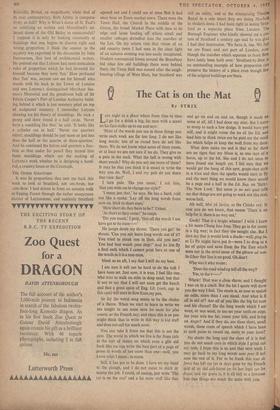City and Suburban
By JOHN BETJEMAN XCUSE me,' said a lady to me when I Was crossing Hammersmith Broadway. She el- bowed me off the traffic island and asserted her rights on the zebra crossing in front of a bus., When people say 'Excuse me' I always reply 'Nn, and they look round, as this lady did, risking her life in doing so, in pained amazement. 'Excuse me is only one of the phrases current te' day which has lost its original meaning. Today it means 'Get out of the way.' Can I help You' sir?' means 'What the hell are you doing here?' 'With due respect' or 'In all respect' means 1 have no respect for your opinions at all.' for years now `To be frank' has meant `To be tin" pardonably rude.' As our language loses its meaning (a Post Office official told a friend of mine the other day that he would 'organise' a telephone for him), so local accents disappear and clichés take their place. There is techno' logical jargon, education jargon, church jargon and so on. I was in Bristol on Sunday exploring Kingsdown, a leafy Georgian suburb of cobbled lanes, steps, pear trees and bow-windowed houses, all threatened with destruction on an airy hill- top in that wonderful city. But I listened in vain as I talked to people for the intrusive liquid which used to be a feature of that part of Bristol. Ernest Bevin had it. He used to put Ts' on to words ending with an 'a' or an 'banana-1'; and, of course, 'Bristol' was origin' ally 'Bristowe.' But there is still in the City of London, among older brokers and companY directors, that delightful thing the 'City accent' which went with an Italianate house with a gravel drive and lamp posts in Streatham or Lewisham and has now migrated to Esher and Sussex. Tbe vowels are rather broad and flat. The speech is slow and shrewdly thoughtful.
THE EYE HAS IT Last month there was a discussion at the Royal Institute of British Architects between architects and art historians on the subject of rules of pro- portion in building. One thing that did emerge was that there was no universal rule of propor- tion. Though the Greeks and*Romans had their rules, these obviously do not apply to the Romanesque buildings of later centuries. And certainly Gothic architecture has quite different systems of proportion even in its latest and most mathematical-looking phases. The architects of the Renaissance had their own rules, but the suc- cessful application of them seems to have de- pended on the individual genius of the architect. Why in late Gothic is the interior of St. Mary Reklcliffe, Bristol, so magnificent, while that of its near contemporary, Bath Abbey, is compara- tively so dull? Why is Wren's dome of St. Paul's so satisfying an outline and Mountford's ad- jacent dome of the Old Bailey so unsuccessful? 1 suppose it is only by looking constantly at buildings that one begins to discern right and wrong proportion. I think the answer to the mystery was expressed in the discussion by John Summerson, that best of architectural writers. He pointed out that Lutycns had most meticulous rules of proportion which he had invented for himself because they were `fun.' How profound that `fun' was, anyone can see for himself who stands with his back to the Tower of London and sees Lutyens's distinguished Merchant Sea- men's Memorial and the ponderous bulk of Sir Edwin Cooper's Port of London Authority build- ing behind it which is just masonry piled on top of sculptured masonry. I remember Lutyens showing me his theory of mouldings. He took a penny and drew round it a half circle. 'Never have a moulding like that,' he said. 'It looks like a cylinder cut in half.' Never use quarters either; mouldings should be just more or just less than the half or the quarter or three-quarters.' And he continued the halves and quarters a frac- tion so that under his pencil they turned into those mouldings which are the making of Lutycns's work whether he is designing a hand- rail, a country house or the Cenotaph.
THE OTHER STRATFORD It was its proportions that sent me back this week to look at Stratford, not -on-Avon, but -atte-Bow. I had driven in from an autumn walk in Epping Forest through the rather anonymous district of Leytonstone, and suddenly Stratford opened out and I could see at once that it had once been an Essex market town. There were the Town Hall, the Church in the middle of the Green, the broad Market Place with inns at its edge and lanes leading off where small and smaller cottages dwindled into the marshes of the Lea. On my return visit that vision of an old country town I had seen in the clear light of an autumn evening was less easily recaptured. Modern commercial fronts around the Broadway hid what few old buildings there were behind them, the Town Hall was named after the neigh- bouring village of West Ham, but Stratford was still an entity, and at the enterprising Theatre Royal in a side street they are doing Macbeth in rrlodern dress. I had been right in seeing Strat- ford as a separate place from London. The Borough Engineer who kindly showed me a pic- ture of Stratford a century ago said he was glad I had that impression. 'We have it, too. We feel we are Essex and not part of London, even though the marshes which separate us from BoW have lately been built over.' Stratford-by-Bow is an outstanding example of how proportion can preserve the history of a place even though few of the original buildings are there.























































 Previous page
Previous page